Purchase Descriptive Analytics
Contents
Purchase Descriptive Analytics#
Imports#
import pandas as pd
import scipy as sp
import seaborn as sns
import matplotlib.pyplot as plt
import sklearn
import numpy as np
import pickle
import joblib
sns.set()
Read Dataset#
df = pd.read_csv("purchase data.csv"); df.head()
| ID | Day | Incidence | Brand | Quantity | Last_Inc_Brand | Last_Inc_Quantity | Price_1 | Price_2 | Price_3 | ... | Promotion_3 | Promotion_4 | Promotion_5 | Sex | Marital status | Age | Education | Income | Occupation | Settlement size | |
|---|---|---|---|---|---|---|---|---|---|---|---|---|---|---|---|---|---|---|---|---|---|
| 0 | 200000001 | 1 | 0 | 0 | 0 | 0 | 0 | 1.59 | 1.87 | 2.01 | ... | 0 | 0 | 0 | 0 | 0 | 47 | 1 | 110866 | 1 | 0 |
| 1 | 200000001 | 11 | 0 | 0 | 0 | 0 | 0 | 1.51 | 1.89 | 1.99 | ... | 0 | 0 | 0 | 0 | 0 | 47 | 1 | 110866 | 1 | 0 |
| 2 | 200000001 | 12 | 0 | 0 | 0 | 0 | 0 | 1.51 | 1.89 | 1.99 | ... | 0 | 0 | 0 | 0 | 0 | 47 | 1 | 110866 | 1 | 0 |
| 3 | 200000001 | 16 | 0 | 0 | 0 | 0 | 0 | 1.52 | 1.89 | 1.98 | ... | 0 | 0 | 0 | 0 | 0 | 47 | 1 | 110866 | 1 | 0 |
| 4 | 200000001 | 18 | 0 | 0 | 0 | 0 | 0 | 1.52 | 1.89 | 1.99 | ... | 0 | 0 | 0 | 0 | 0 | 47 | 1 | 110866 | 1 | 0 |
5 rows × 24 columns
df.shape
(58693, 24)
df.isnull().sum()
ID 0
Day 0
Incidence 0
Brand 0
Quantity 0
Last_Inc_Brand 0
Last_Inc_Quantity 0
Price_1 0
Price_2 0
Price_3 0
Price_4 0
Price_5 0
Promotion_1 0
Promotion_2 0
Promotion_3 0
Promotion_4 0
Promotion_5 0
Sex 0
Marital status 0
Age 0
Education 0
Income 0
Occupation 0
Settlement size 0
dtype: int64
Applying Segmentation Model#
pipeline = joblib.load("cluster_pipeline.pkl"); pipeline
Pipeline(steps=[('standardscaler', StandardScaler()),
('pca', PCA(n_components=4)),
('kmeans', KMeans(n_clusters=4, random_state=42))])
We will extend the clustering function from earlier to generalize our training and prediction
def do_clustering(df, pipeline, drop_cols=None, sel_cols=None, do_fit=False):
y = None
df_new = df.copy()
if drop_cols: df_new = df_new.drop(columns=drop_cols, axis=1)
df_filter = df_new.copy()
if sel_cols: df_filter = df_new[sel_cols]
if do_fit:y = pipeline.fit_predict(df_filter)
else: y = pipeline.predict(df_filter)
if 'pca' in pipeline.named_steps:
m = pipeline.named_steps['pca']
comp_names = [f"PCA{i+1}" for i in range(m.n_components)]
transform_df = df_filter.copy()
for step in pipeline.named_steps:
transform_df = pipeline.named_steps[step].transform(transform_df)
if step == "pca": break
pca_df = pd.DataFrame(transform_df,
columns=comp_names,
index=df_filter.index)
df_new = pd.concat([df_new, pca_df], axis=1)
df_new['y'] = y+1
return df_new, pipeline
sel_cols = ['Sex','Marital status','Age','Education','Income','Occupation','Settlement size']
df_segments, _ = do_clustering(df, pipeline, sel_cols=sel_cols)
# df_segments["Visits"] = 1
names = {1:"Standard",
2:"Career-Focussed",
3:"Fewer-Opportunities",
4:"Well-off"}
df_segments['labels'] = df_segments['y'].map(names)
df_segments.head().T
## May be we might include pca names later as well
| 0 | 1 | 2 | 3 | 4 | |
|---|---|---|---|---|---|
| ID | 200000001 | 200000001 | 200000001 | 200000001 | 200000001 |
| Day | 1 | 11 | 12 | 16 | 18 |
| Incidence | 0 | 0 | 0 | 0 | 0 |
| Brand | 0 | 0 | 0 | 0 | 0 |
| Quantity | 0 | 0 | 0 | 0 | 0 |
| Last_Inc_Brand | 0 | 0 | 0 | 0 | 0 |
| Last_Inc_Quantity | 0 | 0 | 0 | 0 | 0 |
| Price_1 | 1.59 | 1.51 | 1.51 | 1.52 | 1.52 |
| Price_2 | 1.87 | 1.89 | 1.89 | 1.89 | 1.89 |
| Price_3 | 2.01 | 1.99 | 1.99 | 1.98 | 1.99 |
| Price_4 | 2.09 | 2.09 | 2.09 | 2.09 | 2.09 |
| Price_5 | 2.66 | 2.66 | 2.66 | 2.66 | 2.66 |
| Promotion_1 | 0 | 0 | 0 | 0 | 0 |
| Promotion_2 | 1 | 0 | 0 | 0 | 0 |
| Promotion_3 | 0 | 0 | 0 | 0 | 0 |
| Promotion_4 | 0 | 0 | 0 | 0 | 0 |
| Promotion_5 | 0 | 0 | 0 | 0 | 0 |
| Sex | 0 | 0 | 0 | 0 | 0 |
| Marital status | 0 | 0 | 0 | 0 | 0 |
| Age | 47 | 47 | 47 | 47 | 47 |
| Education | 1 | 1 | 1 | 1 | 1 |
| Income | 110866 | 110866 | 110866 | 110866 | 110866 |
| Occupation | 1 | 1 | 1 | 1 | 1 |
| Settlement size | 0 | 0 | 0 | 0 | 0 |
| PCA1 | 0.362152 | 0.362152 | 0.362152 | 0.362152 | 0.362152 |
| PCA2 | -0.639557 | -0.639557 | -0.639557 | -0.639557 | -0.639557 |
| PCA3 | 1.462706 | 1.462706 | 1.462706 | 1.462706 | 1.462706 |
| PCA4 | -0.593242 | -0.593242 | -0.593242 | -0.593242 | -0.593242 |
| y | 3 | 3 | 3 | 3 | 3 |
| labels | Fewer-Opportunities | Fewer-Opportunities | Fewer-Opportunities | Fewer-Opportunities | Fewer-Opportunities |
By Consumer#
df_consumer = df_segments[['ID', 'Incidence', 'labels']].groupby('ID').agg({'Incidence':['count', 'sum', 'mean'],'labels':['first']})
df_consumer.columns = ["_".join(i) for i in df_consumer.columns]
df_consumer.head()
| Incidence_count | Incidence_sum | Incidence_mean | labels_first | |
|---|---|---|---|---|
| ID | ||||
| 200000001 | 101 | 9 | 0.089109 | Fewer-Opportunities |
| 200000002 | 87 | 11 | 0.126437 | Well-off |
| 200000003 | 97 | 10 | 0.103093 | Fewer-Opportunities |
| 200000004 | 85 | 11 | 0.129412 | Fewer-Opportunities |
| 200000005 | 111 | 13 | 0.117117 | Career-Focussed |
df_consumer= df_consumer.rename({'Incidence_count':'N_Visits',
'Incidence_sum': 'N_Purchases',
'Incidence_mean':'Avg_Purchases',
'labels_first': 'Segments'}, axis=1)
df_consumer.head()
| N_Visits | N_Purchases | Avg_Purchases | Segments | |
|---|---|---|---|---|
| ID | ||||
| 200000001 | 101 | 9 | 0.089109 | Fewer-Opportunities |
| 200000002 | 87 | 11 | 0.126437 | Well-off |
| 200000003 | 97 | 10 | 0.103093 | Fewer-Opportunities |
| 200000004 | 85 | 11 | 0.129412 | Fewer-Opportunities |
| 200000005 | 111 | 13 | 0.117117 | Career-Focussed |
Volume of Consumer Per Segment#
sorted(df_consumer['Segments'].unique().tolist())
['Career-Focussed', 'Fewer-Opportunities', 'Standard', 'Well-off']
my_pallete=dict(zip(sorted(df_consumer['Segments'].unique().tolist()),['g', 'r', 'b', 'y'])); my_pallete
{'Career-Focussed': 'g',
'Fewer-Opportunities': 'r',
'Standard': 'b',
'Well-off': 'y'}
df_segment_id = df_consumer.reset_index()[['Segments', 'ID']].groupby('Segments').count()
df_segment_id.plot(kind='pie', y='ID', autopct='%1.1f%%', startangle=270, fontsize=17, figsize=(10,10), colors=my_pallete.values(), title='Volume of Customer per Segment') # % Based on Consumer Count
<AxesSubplot:title={'center':'Volume of Customer per Segment'}, ylabel='ID'>
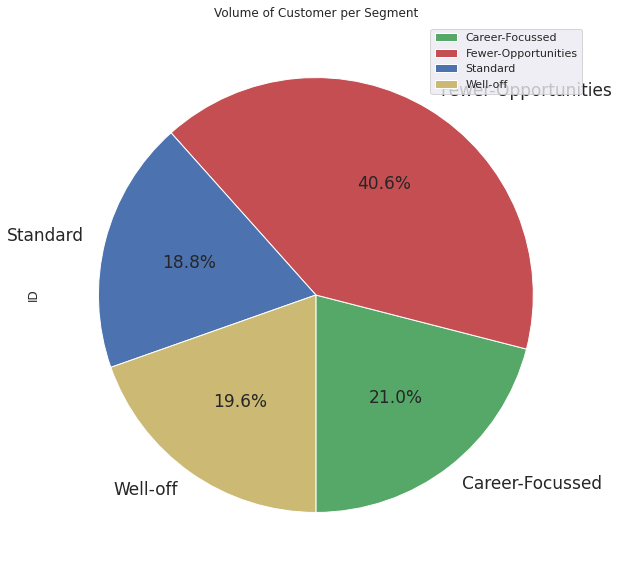
Purchase Occasion and Purchase Incidence#
Note
Defines Qualitative Behaviour based on purchase behaviour per segment
df_segment_visits = df_consumer[['Segments', 'N_Visits', 'N_Purchases', 'Avg_Purchases']].groupby('Segments').agg(['sum', 'mean', 'std']); df_segment_visits
| N_Visits | N_Purchases | Avg_Purchases | |||||||
|---|---|---|---|---|---|---|---|---|---|
| sum | mean | std | sum | mean | std | sum | mean | std | |
| Segments | |||||||||
| Career-Focussed | 13065 | 124.428571 | 46.085176 | 4394 | 41.847619 | 55.433741 | 30.886225 | 0.294155 | 0.207227 |
| Fewer-Opportunities | 23085 | 113.719212 | 16.236037 | 4622 | 22.768473 | 13.584739 | 40.955542 | 0.201751 | 0.118552 |
| Standard | 11048 | 117.531915 | 18.410903 | 2231 | 23.734043 | 13.414946 | 19.315218 | 0.205481 | 0.116267 |
| Well-off | 11495 | 117.295918 | 20.716152 | 3391 | 34.602041 | 25.900579 | 27.878841 | 0.284478 | 0.171787 |
How often do people from a segment visit the store?#
sns.barplot(data=df_consumer, x='Segments', y='N_Visits', palette=my_pallete, estimator=np.mean, ci='sd').set(title='Average number of store visits by segment')
[Text(0.5, 1.0, 'Average number of store visits by segment')]
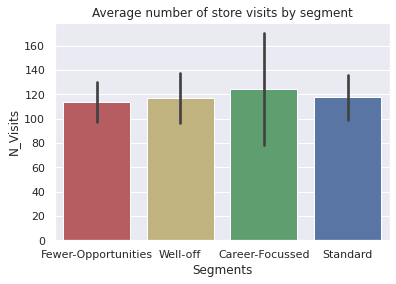
How often do people make purchases when they visit the store?#
sns.barplot(data=df_consumer, x='Segments', y='N_Purchases', palette=my_pallete, estimator=np.mean, ci='sd').set(title='Number of Purchase incidences by segment')
[Text(0.5, 1.0, 'Number of Purchase incidences by segment')]
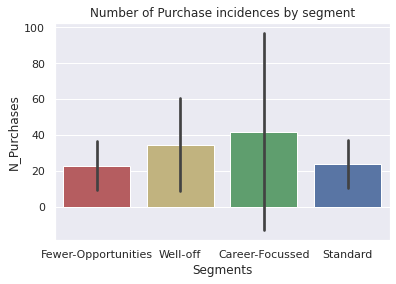
Note
Most varied behaviour in Career-Focussed segment in terms of avg. number of store visits and conversions to purchases. May be have sub segments of people who like to spend money differently
Most homogeneous segment is Fewer Opportunities
Standard seem to be consistent/ homogeneous as well
Slightly higher variation in purchase behavior of well off.
Purchase Frequency Relative to store visits(Avg_Purchases)?#
sns.barplot(data=df_consumer, x='Segments', y='Avg_Purchases', palette=my_pallete, estimator=np.mean, ci='sd').set(title='Purchase Frequency relative to store visits')
[Text(0.5, 1.0, 'Purchase Frequency relative to store visits')]
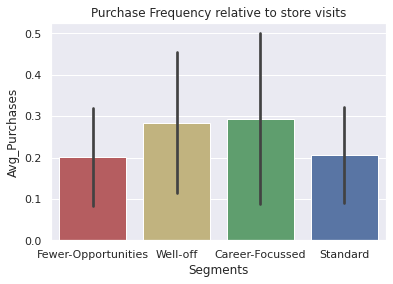
Brand Choice#
P(Choosing Brand X |Given Purchase Incidence)
np.sort(df_segments['Brand'].unique())
array([0, 1, 2, 3, 4, 5])
df_segments[['Incidence','Brand']].groupby('Brand').count()/df_segments.shape[0]
| Incidence | |
|---|---|
| Brand | |
| 0 | 0.750601 |
| 1 | 0.023001 |
| 2 | 0.077386 |
| 3 | 0.014329 |
| 4 | 0.049870 |
| 5 | 0.084814 |
df_segments['Incidence'].sum()/df_segments['Incidence'].count() # Only ~25% visits leads to purchases of one or other brand
0.24939941730700424
(df_segments[df_segments['Brand']>0]['Incidence']==0).sum() # Sanity check for data no brand instances with non zero entry has incidence reported as 0
0
df_segments_purchase = df_segments[df_segments['Incidence']==1].copy(); df_segments_purchase.shape
(14638, 30)
Brand Proportions : Which segment is most important for a particular brand?#
Given a Store Visit. What percentage of brand preference given different segments? (Of Chocalate)#
df_segments_brand = df_segments_purchase[['labels','Brand']].groupby(['labels','Brand'])['Brand'].count().unstack(); df_segments_brand
sns.heatmap((df_segments_brand*100/df_segments_brand.sum()).T, annot=True, cmap='PuBu')
<AxesSubplot:xlabel='labels', ylabel='Brand'>

Inference
Whenever Brand 1 was chosen: Fewer-Opportunities and Standard had leading share
Brand 2 choice had highest share from Fewer-Opportunities Group
Brand 3 choice had highest share from Standard Group
Brand 4 choice had highest share from Well Off
Brand 5 choice had highest share from Career Focussed
Quantity Sales split by segment proportion?#
df_segments_quantity = df_segments_purchase[['labels','Brand', 'Quantity']].groupby(['labels','Brand'])['Quantity'].sum().unstack(); df_segments_quantity
sns.heatmap((df_segments_quantity*100/df_segments_quantity.sum()).T, annot=True, cmap='PuBu')
<AxesSubplot:xlabel='labels', ylabel='Brand'>
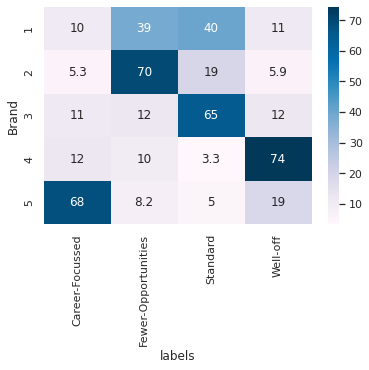
df_segments_purchase['Revenue'] = 0
df_segments_purchase['Revenue']= df_segments_purchase.apply(lambda row: row['Quantity']*row[f"Price_{row['Brand']}"], axis=1)
Brand Revenue proportion generated by different segments ( Segment proportion in brand revenue)#
df_segments_revenue = df_segments_purchase[['labels','Brand', 'Revenue']].groupby(['labels','Brand'])['Revenue'].sum().unstack(); df_segments_revenue
sns.heatmap((df_segments_revenue*100/df_segments_revenue.sum()).T, annot=True, cmap='PuBu')
<AxesSubplot:xlabel='labels', ylabel='Brand'>
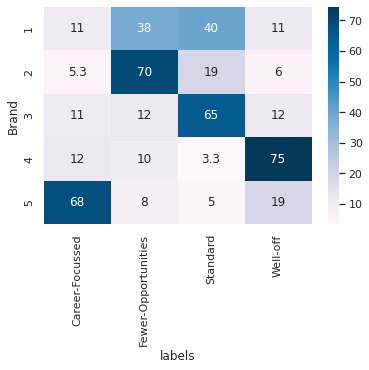
From Segment Persepective: On which brand does the segment spends it’s most money/wealth?#
Segment Buying pattern for different brands#
sns.heatmap((df_segments_brand.T/df_segments_brand.sum(axis=1)).T, annot=True, cmap='PuBu')
<AxesSubplot:xlabel='Brand', ylabel='labels'>

sns.heatmap((df_segments_quantity.T/df_segments_quantity.sum(axis=1)).T, annot=True, cmap='PuBu')
<AxesSubplot:xlabel='Brand', ylabel='labels'>
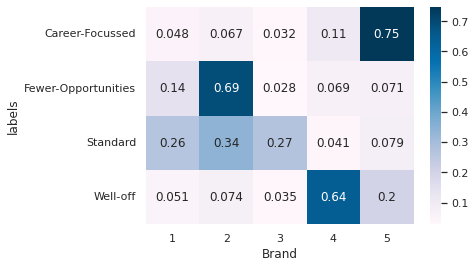
sns.heatmap((df_segments_revenue.T/df_segments_revenue.sum(axis=1)).T, annot=True, cmap='PuBu')
<AxesSubplot:xlabel='Brand', ylabel='labels'>

Inference
Career-Focussed really prefer to spend money on Brand 5
Fewer-opportunities prefer to spend money on Brand 2
Standard has split preference to spend money on between Brand2 and Brand 3 with significant contribution also from Brand 1
Well off spends most money on Brand 4 but substantial portion is also spent on Brand 5
Mean Price of Different Brands#
df_segments_purchase.filter(regex='Price*').mean()
Price_1 1.384559
Price_2 1.764717
Price_3 2.006694
Price_4 2.159658
Price_5 2.654296
dtype: float64


